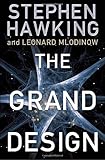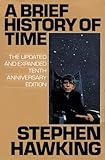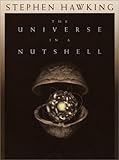|
|
Help |
| Home - Scientists - Hawking Stephen (Books) | |
e99 Online Shopping Mall
|
|
Help |
| Home - Scientists - Hawking Stephen (Books) | |
| 1-20 of 106 | Next 20 |
click price to see details click image to enlarge click link to go to the store
| 1. The Grand Design by Stephen Hawking, Leonard Mlodinow | |
 | Hardcover: 208
Pages
(2010-09-07)
list price: US$28.00 -- used & new: US$11.99 (price subject to change: see help) Asin: 0553805371 Average Customer Review: Canada | United Kingdom | Germany | France | Japan |
|
Editorial Review Product Description How can we understand the world in which we find ourselves?Over twenty years ago I wrote A Brief History of Time, to try to explain where the universe came from, and where it is going.But that book left some important questions unanswered.Why is there a universe--why is there something rather than nothing?Why do we exist?Why are the laws of nature what they are?Did the universe need a designer and creator? It was Einstein’s dream to discover the grand design of the universe, a single theory that explains everything. However, physicists in Einstein’s day hadn’t made enough progress in understanding the forces of nature for that to be a realistic goal.And by the time I had begun writing A Brief History of Time, there were still several key advances that had not yet been made that would prevent us from fulfilling Einstein’s dream.But in recent years the development of M-theory, the top-down approach to cosmology, and new observations such as those made by satellites like NASA’s COBE and WMAP, have brought us closer than ever to that single theory, and to being able to answer those deepest of questions.And so Leonard Mlodinow and I set out to write a sequel to A Brief History of Time to attempt to answer the Ultimate Question of Life, the Universe and Everything.The result is The Grand Design, the product of our four-year effort. In The Grand Design we explain why, according to quantum theory, the cosmos does not have just a single existence, or history, but rather that every possible history of the universe exists simultaneously.We question the conventional concept of reality, posing instead a "model-dependent" theory of reality.We discuss how the laws of our particular universe are extraordinarily finely tuned so as to allow for our existence, and show why quantum theory predicts the multiverse--the idea that ours is just one of many universes that appeared spontaneously out of nothing, each with different laws of nature.And we assess M-Theory, an explanation of the laws governing the multiverse, and the only viable candidate for a complete "theory of everything."As we promise in our opening chapter, unlike the answer to the Ultimate Question of Life given in the Hitchhiker’s Guide to the Galaxy, the answer we provide in The Grand Design is not, simply, "42." (Photo © Philip Waterson, LBIPP, LRPS) Customer Reviews (262)
| |
| 2. A Briefer History of Time by Stephen Hawking, Leonard Mlodinow | |
 | Paperback: 176
Pages
(2008-05-13)
list price: US$22.00 -- used & new: US$11.49 (price subject to change: see help) Asin: 0553385461 Average Customer Review: Canada | United Kingdom | Germany | France | Japan |
|
Editorial Review Product Description Customer Reviews (100)
| |
| 3. The Theory of Everything: The Origin and Fate of the Universe by Stephen W Hawking | |
 | Hardcover: 136
Pages
(2006-05-01)
list price: US$24.95 -- used & new: US$15.88 (price subject to change: see help) Asin: 1597775088 Average Customer Review: Canada | United Kingdom | Germany | France | Japan |
|
Editorial Review Product Description Customer Reviews (37)
| |
| 4. A Brief History of Time by Stephen Hawking | |
 | Paperback: 224
Pages
(1998-09-01)
list price: US$18.00 -- used & new: US$9.43 (price subject to change: see help) Asin: 0553380168 Average Customer Review: Canada | United Kingdom | Germany | France | Japan |
|
Editorial Review Product Description Now a decade later, this edition updates the chapters throughout to document those advances, and also includes an entirely new chapter on Wormholes and Time Travel and a new introduction. It make vividly clear why A Brief History of Time has transformed our view of the universe. Customer Reviews (331)
| |
| 5. A Stubbornly Persistent Illusion: The Essential Scientific Works of Albert Einstein | |
 | Paperback: 480
Pages
(2009-09-29)
list price: US$18.95 -- used & new: US$8.89 (price subject to change: see help) Asin: 076243564X Average Customer Review: Canada | United Kingdom | Germany | France | Japan |
|
Editorial Review Product Description Customer Reviews (7)
| |
| 6. Stephen Hawking: A Biography by Kristine Larsen | |
 | Paperback: 215
Pages
(2007-10-31)
list price: US$17.98 -- used & new: US$4.22 (price subject to change: see help) Asin: 1591025745 Average Customer Review: Canada | United Kingdom | Germany | France | Japan |
|
Editorial Review Product Description Topics include Hawking's early lack of focus as a college student; the impact of ALS on his career and personal life; his groundbreaking work on radiating black holes; his later cutting-edge theories of black holes, cosmology, and the anthropic principle; the amazing publishing success of A Brief History of Time; and his status as a pop icon and spokesperson for the interplay of science and society. Larsen situates Hawking's sometimes-controversial work within the broader context of scientific peer review and public debate, and discusses his personal life with compassion, respect, and honesty. Customer Reviews (3)
| |
| 7. George's Cosmic Treasure Hunt by Lucy Hawking, Stephen Hawking | |
 | Hardcover: 320
Pages
(2009-05-19)
list price: US$18.99 -- used & new: US$11.02 (price subject to change: see help) Asin: 1416986715 Average Customer Review: Canada | United Kingdom | Germany | France | Japan |
|
Editorial Review Product Description Is it a message from an alien? Could there be life out there? How do you find a planet in outer space? And if you could talk to aliens, what would you say?An action-packed roller-coaster ride into a dramatic treasure hunt across the cosmos, this terrific adventure is FILLED with the LATEST scientific knowledge about our Universe, including special essays from some of the top scientists in the world! Customer Reviews (9)
| |
| 8. George's Secret Key to the Universe by Stephen Hawking, Lucy Hawking | |
 | Paperback: 336
Pages
(2009-05-19)
list price: US$9.99 -- used & new: US$5.82 (price subject to change: see help) Asin: 1416985840 Average Customer Review: Canada | United Kingdom | Germany | France | Japan |
|
Editorial Review Product Description Customer Reviews (43)
| |
| 9. The Illustrated On the Shoulders of Giants: The Great Works of Physics and Astronomy by Stephen Hawking | |
 | Hardcover: 256
Pages
(2004-10-13)
list price: US$35.00 -- used & new: US$10.16 (price subject to change: see help) Asin: 0762418982 Average Customer Review: Canada | United Kingdom | Germany | France | Japan |
|
Editorial Review Product Description Customer Reviews (6)
| |
| 10. God Created the Integers: The Mathematical Breakthroughs that Changed History by Stephen Hawking | |
 | Paperback: 1376
Pages
(2007-10-09)
list price: US$22.95 -- used & new: US$1.74 (price subject to change: see help) Asin: 0762430044 Average Customer Review: Canada | United Kingdom | Germany | France | Japan |
|
Editorial Review Product Description Readers get a window into the minds of these geniuses and can see the unfolding thought process as it leads, inevitably, to the high-water marks in mathematical thinking. This new edition comes with an index to make it a valuable and easy-to-use research and reference tool. Customer Reviews (33)
| |
| 11. Stephen Hawking's Universe: The Cosmos Explained by David Filkin | |
 | Paperback: 304
Pages
(1998-10-09)
list price: US$24.95 -- used & new: US$13.33 (price subject to change: see help) Asin: 0465081983 Average Customer Review: Canada | United Kingdom | Germany | France | Japan |
|
Editorial Review Product Description Customer Reviews (25)
| |
| 12. The Universe in a Nutshell by Stephen William Hawking | |
 | Hardcover: 224
Pages
(2001-11-06)
list price: US$35.00 -- used & new: US$15.36 (price subject to change: see help) Asin: 055380202X Average Customer Review: Canada | United Kingdom | Germany | France | Japan |
|
Editorial Review Product Description Does it succeed? Yes and no. While Hawking offers genuinely accessible context for such complexities as string theory and the nature of time, it's when he must translate equations to sentences that the limits of language get in the way. But Hawking has simplified the origin of the universe, the nature of space and time, and what holds it all together to an unprecedented degree, inviting nonscientists to share his obvious awe and love of the unseen forces that shape it all. Yes, it's difficult reading, but it's worth it. Hawking is one of the great geniuses of our time, a man whose life has been devoted to thinking in the abstract about the universe. With his help, and pictures--lots of pictures--we can seek to understand a bit more of the cosmos. --Therese Littleton Customer Reviews (188)
| |
| 13. Illustrated Theory of Everything: The Origin and Fate of the Universe by Stephen Hawking | |
 | Hardcover: 117
Pages
(2009-09-15)
list price: US$24.95 -- used & new: US$16.17 (price subject to change: see help) Asin: 1597776114 Average Customer Review: Canada | United Kingdom | Germany | France | Japan |
|
Editorial Review Product Description Stephen Hawking is widely believed to be one of the world’s greatest minds, a brilliant theoretical physicist whose work helped reconfigure models of the universe and define what’s in it. Imagine sitting in a room listening to Hawking discuss these achievements and place them in historical context; it would be like hearing Christopher Columbus on the New World. Customer Reviews (7)
| |
| 14. The Nature of Space and Time: (New in Paper) (The Isaac Newton Institute Series of Lectures) by Stephen Hawking, Roger Penrose | |
 | Paperback: 160
Pages
(2010-02-28)
list price: US$14.95 -- used & new: US$7.25 (price subject to change: see help) Asin: 0691145709 Average Customer Review: Canada | United Kingdom | Germany | France | Japan |
|
Editorial Review Product Description Hawking, clever and playful as usual, sides with Bohr and the Copenhageninterpretation and builds a strong case for quantum gravity. Penrose,inevitably a bit dry in comparison, shares Einstein's horror at suchintuition-blasting thought experiments as Schrödinger's long-sufferingcat--and scores just as many points for general relativity. The math istough going for lay readers, but a few leaps of faith will carry themthrough to some deeply thought-provoking rhetoric. Though no questionsfind final answers in The Nature of Space and Time, the quality ofdiscourse should be enough to satisfy the scientifically curious. --Rob Lightner Customer Reviews (12) | |
| 15. The Illustrated Brief History of Time, Updated and Expanded Edition by Stephen William Hawking | |
 | Hardcover: 248
Pages
(1996)
list price: US$40.00 -- used & new: US$21.28 (price subject to change: see help) Asin: 0553103741 Average Customer Review: Canada | United Kingdom | Germany | France | Japan |
|
Editorial Review Product Description The book was on the cutting edge of what was then known about the nature of the universe, but since then there have been extraordinary advances in the Eager to bring to his original text the new knowledge revealed by these many observations, as well as his most recent research, for this revised and expanded edition Hawking has prepared a new introduction to the book, revised and updated the original chapters throughout, and written an entirely new chapter on the fascinating subject of wormholes and time travel. In addition, to heighten understanding of complex concepts that readers may have found difficult to grasp despite the clarity and wit of Hawking's writing, this edition is magnificently enhanced throughout with more than 240 full-color illustrations, including satellite images, photographs made possible by spectacular new technological advances such as the Hubble telescope, and computer- generated images of three- and four-dimensional realities. Detailed captions clarify these illustrations, enabling readers to experience the vastness of intergalactic space, the nature of black holes, and the microcosmic world of A classic work that now brings to the reader the latest understanding of cosmology, The Illustrated A Brief History of Time is the story of the ongoing search for the tantalizing secrets at the heart of time and space. Customer Reviews (58)
| |
| 16. Black Holes and Baby Universes and Other Essays by Stephen W. Hawking | |
 | Paperback: 192
Pages
(1994-09-01)
list price: US$18.00 -- used & new: US$4.98 (price subject to change: see help) Asin: 0553374117 Average Customer Review: Canada | United Kingdom | Germany | France | Japan |
|
Editorial Review Product Description Customer Reviews (46)
| |
| 17. The Future of Spacetime by Stephen William Hawking, Kip S. Thorne, Igor Novikov, Timothy Ferris, Alan Lightman | |
 | Paperback: 224
Pages
(2003-06)
list price: US$16.95 -- used & new: US$5.97 (price subject to change: see help) Asin: 039332446X Average Customer Review: Canada | United Kingdom | Germany | France | Japan |
|
Editorial Review Product Description Our minds tell us that some things in the universe must be true. The New Physics tells us that they are not, and in the process, blurs the line between science and science fiction. Here are six accessible essays by those who walk that line, moving ever further out in discovering the patterns of nature, aimed at readers who share their fascination with the deepest mysteries of the universe. Customer Reviews (9)
| |
| 18. On The Shoulders Of Giants by Stephen Hawking | |
 | Paperback: 1280
Pages
(2003-12-25)
list price: US$22.95 -- used & new: US$10.49 (price subject to change: see help) Asin: 076241698X Average Customer Review: Canada | United Kingdom | Germany | France | Japan |
|
Editorial Review Product Description Customer Reviews (16)
| |
| 19. A Brief History of Time and the Universe in a Nutshell by Stephen W. Hawking | |
 | Paperback:
Pages
(2007-06-07)
list price: US$14.98 -- used & new: US$17.97 (price subject to change: see help) Asin: 0307291227 Average Customer Review: Canada | United Kingdom | Germany | France | Japan |
|
Editorial Review Product Description Customer Reviews (5)
| |
| 20. | |
Canada | United Kingdom | Germany | France | Japan | |
| 1-20 of 106 | Next 20 |